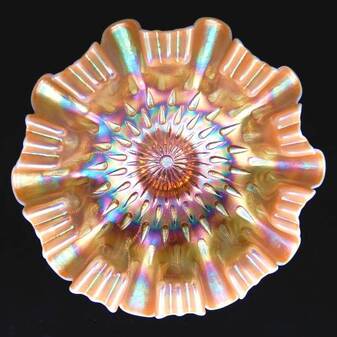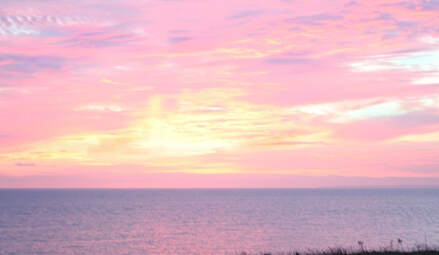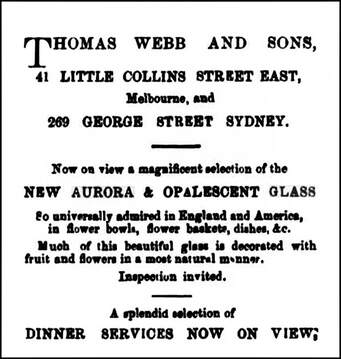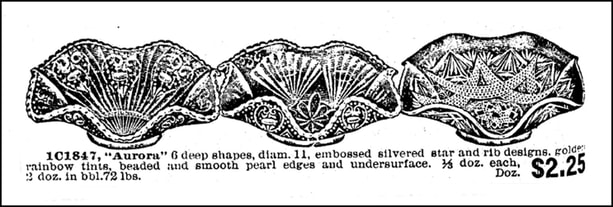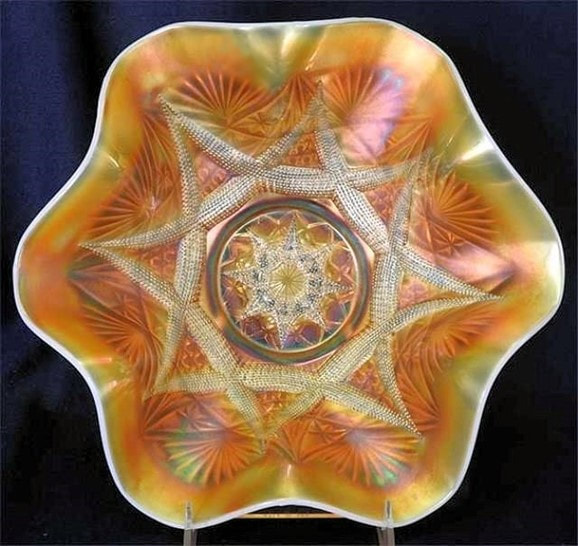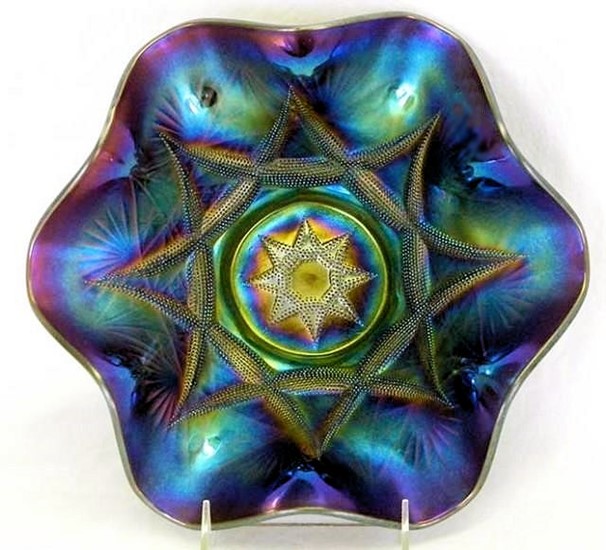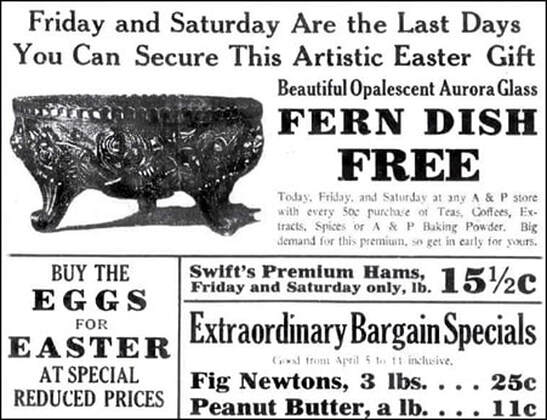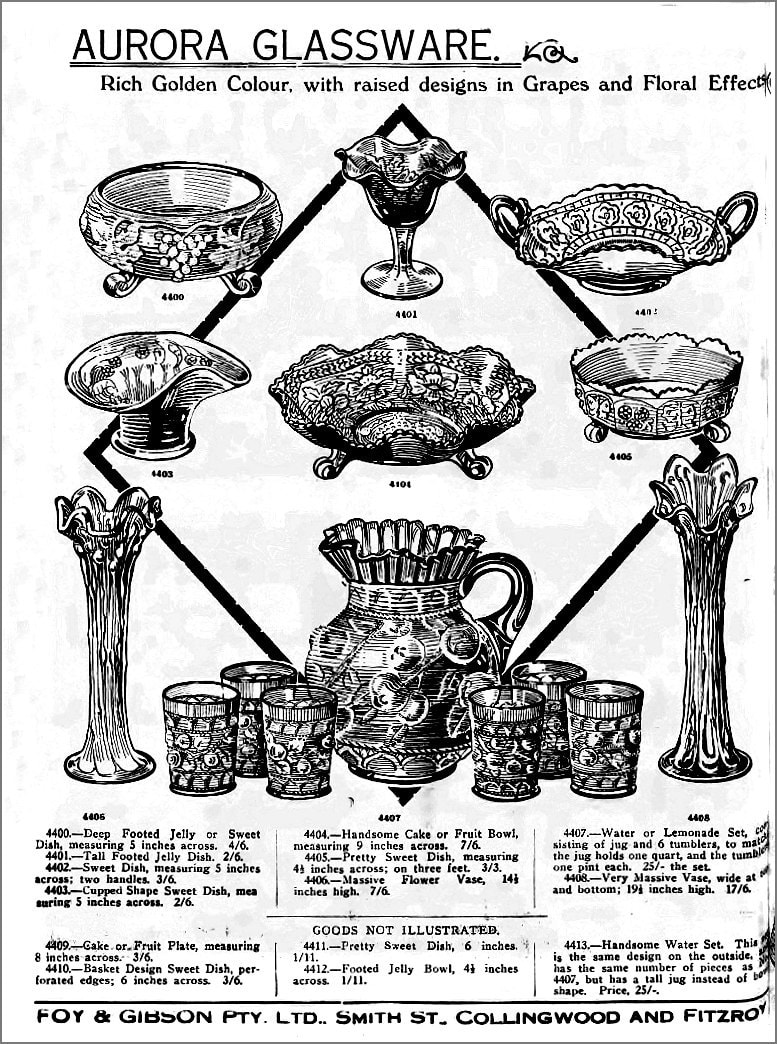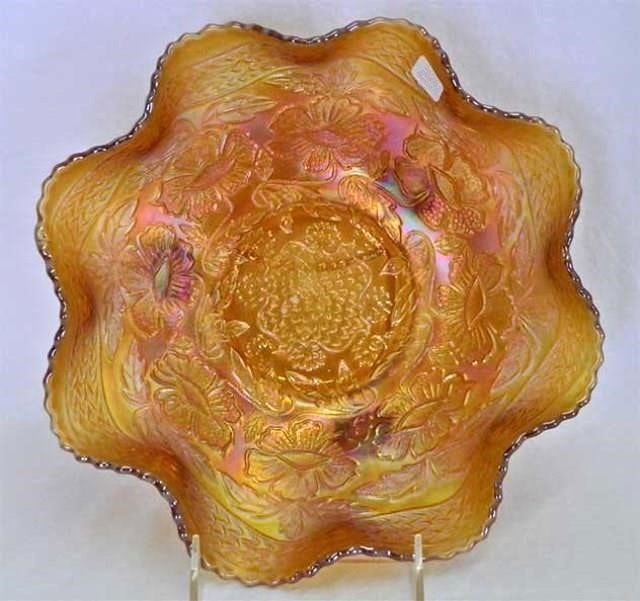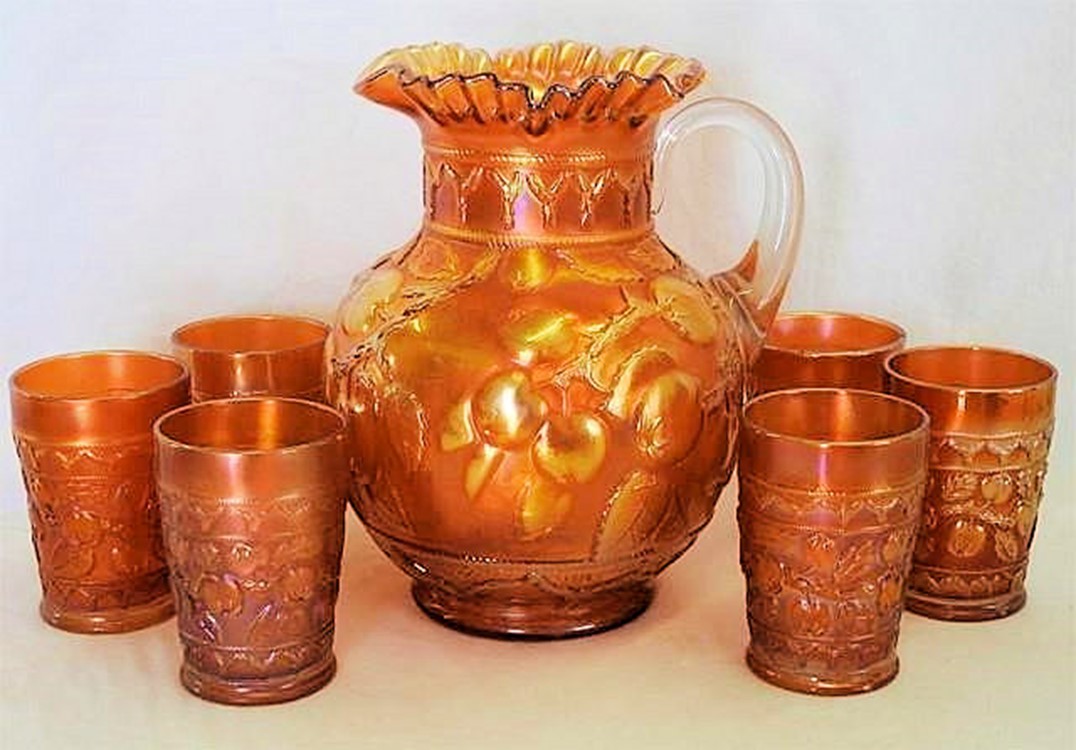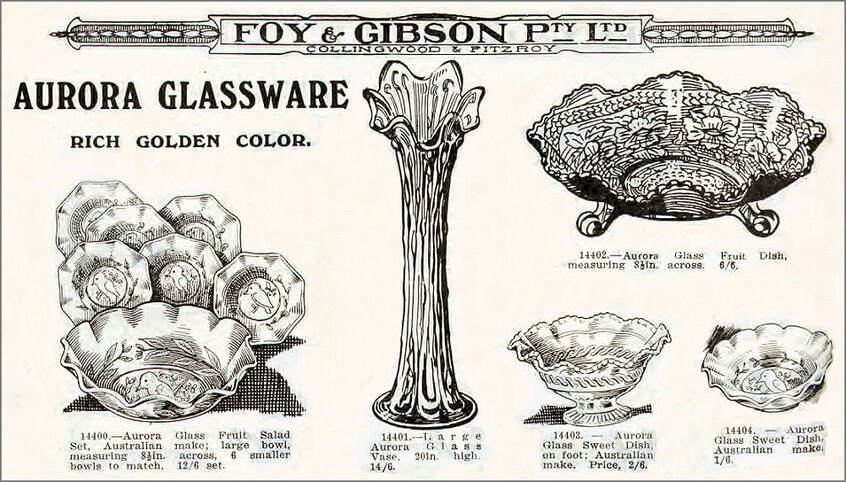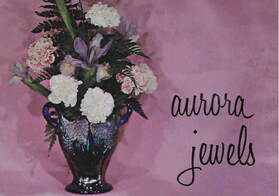"Aurora"
Descriptive marketing speak for iridescent glass
We know how the story ends. Out of around one hundred different names that were used for iridescent glass over the decades, in the 1940s and 50s one name rose to prominence over all others … and it stuck. Carnival Glass is what it became known as.
Collectors all over the world came together to use that term. But what about some of the other names used along the way? In the early days of Carnival, terms like Golden Sunset, Pompeian and Venetian were used. A favourite was also Rubigold, a delightfully evocative term chosen by Imperial for what we know as marigold.
And yet another term was Aurora. Let’s follow the story of this descriptive marketing term, which actually begins way back in the 1880s.
We know how the story ends. Out of around one hundred different names that were used for iridescent glass over the decades, in the 1940s and 50s one name rose to prominence over all others … and it stuck. Carnival Glass is what it became known as.
Collectors all over the world came together to use that term. But what about some of the other names used along the way? In the early days of Carnival, terms like Golden Sunset, Pompeian and Venetian were used. A favourite was also Rubigold, a delightfully evocative term chosen by Imperial for what we know as marigold.
And yet another term was Aurora. Let’s follow the story of this descriptive marketing term, which actually begins way back in the 1880s.
|
Dugan’s Raindrops – photo by Stephen Thistlewood
|
The Solent sky
Aurora is the Goddess of dawn in Roman mythology. The sunrise, the glory of golden light breaking in an azure blue sky, reminds us of the colours of iridescence. The term “aurora” is also used to refer to a natural polar phenomenon, with vivid light effects, often showing golden red and aqua tones. |
|
After the creation of iridescence on glass in Bohemia in the 1860s, many attempted to emulate the new look. Thomas Webb in England was one of the glass makers inspired to produce glorious iridescent glassware. Webb sold and exhibited widely, especially in Australia, as you can see from the 1884 ad on the right offering “New Aurora and Opalescent Glass”. The “Aurora” items were iridescent. Fast forward just a few years and cross the Atlantic to America. In 1910 at the Pittsburgh Glass fair, Dugan displayed three rooms full of marigold Carnival that was described in the Glass journals of the time, as the “Aurora” offering. January 1910 “Crockery and Glass Journal”
|
The “Pottery and Glass Salesman” journal added further information regarding the showrooms of Dugan’s New York agent, William Dealing, writing “William Dealing … is showing the Dugan glassware. He has set aside one entire table for the Aurora Iris ware (Ed. marigold) which is steadily growing in demand. For popular-priced glassware it is better than one might naturally expect. There is a luster and general excellence of finish not ordinarily found in so-called cheap goods. The display is made up of trays, comports, bowls and numerous fancy pieces. The African goods (Ed. amethyst and purple) shown from the same factory are also attracting attention through the unusual beauty of their iridescent effects. Punch bowls and cups are featured.”
|
On the immediate right is a Dugan Ski Star bowl in peach opal, showing rich marigold effects. The marigold iridescence is what was called Aurora. On the far right is a Ski Star bowl in purple. The dark and intense vivid iridescence is what was referred to in the above quote from the “Pottery and Glass Salesman” as “African goods”. The base glass of these dark items is often the colour known as Oxblood. Both images are courtesy of Seeck Auctions. |
|
This ad on the right, from the “Washington Times” in 1912, is a fascinating one. Above the eggs for Easter, the Fig Newtons and the peanut butter we see a delightful offering – an Imperial Rose fernery (OMN American Beauty Rose aka Lustre Rose). You’ll notice that this “Fern Dish” was described as “Opalescent Aurora Glass”. In fact, the advertiser was incorrect, the correct word was iridescent (not opalescent); that was a common mistake made back then and we have often seen iridescent glass described in newspaper ads as opalescent. Looks like the early Dugan term for marigold Carnival – Aurora – was picked up by the advertiser, instead of the original Imperial term “Rubigold”. Now fast forward a few more years and cross the Pacific. The beautifully drawn ad shown below featured Fenton’s Carnival. It was for the Australian department store, Foy & Gibson, and it was all described as “Aurora Glassware – Rich Golden Colour” – marigold Carnival, of course. The ad was dated 1922, a year or so before Australia’s Crown Crystal Glass began to register designs for their own Carnival in 1923 (which they called “Iridescent” for marigold and “De Lustre” for the darker purple shades). A vast amount of USA Classic Carnival was imported into Australia from as early as 1911, especially just after WWI and through the 1920s. Various descriptive marketing terms were used for it – Rubigold, Sunrise, Sunkist, Cloth o’ Gold as well as Aurora. |
Above: a 1922 sales ad for Foy & Gibson in Australia.
The “Aurora Glassware” being offered was all Classic Carnival made by Fenton, imported from the USA.
The items shown in the ad are, left to right:
Top row - Vintage fernery, probably Blackberry Bramble comport or maybe Peacock & Urn or Vintage comport, Persian Medallion handled bonbon.
Middle row: Blackberry Spray two sides up, Two Flowers large footed bowl, Butterfly & Berry footed bowl.
Bottom row: Two April Showers vases either side of an Apple Tree water set.
The “Aurora Glassware” being offered was all Classic Carnival made by Fenton, imported from the USA.
The items shown in the ad are, left to right:
Top row - Vintage fernery, probably Blackberry Bramble comport or maybe Peacock & Urn or Vintage comport, Persian Medallion handled bonbon.
Middle row: Blackberry Spray two sides up, Two Flowers large footed bowl, Butterfly & Berry footed bowl.
Bottom row: Two April Showers vases either side of an Apple Tree water set.
Above: left is a Two Flowers master berry bowl, and right an Apple Tree water set, both in marigold. Courtesy of Seeck Auctions.
This delightful Foy & Gibson ad is from 1923-24 and presents a delightful array of “Aurora Glassware” – Foy’s marketing term for Carnival which they used for both domestic Australian and foreign imported glassware.
|
This ad is especially interesting as it shows clearly how the use of the descriptive marketing term “Aurora” to refer to Carnival Glass had indeed spread from its origins to Australia. The ad offered a mixture of both Classic American Carnival and the newly introduced Australian Carnival made by Crown Crystal. All the items were marigold (a “rich golden color”).
The items illustrated are (left to right): Kingfisher berry set (“Fruit Salad Set”) by Crown Crystal, April Showers vase by Fenton, Two Flowers large bowl (“Fruit Dish”) by Fenton, Broken Chain “Sweet Dish” by Crown Crystal, and an individual Kingfisher berry or nappy (“Sweet Dish”) by Crown Crystal. |
|
To complete the cycle, use of the term "Aurora" was incorporated by Imperial Glass into a new Contemporary Carnival colour line introduced in mid 1970 - "Aurora Jewels". It was a line of vividly iridised, rich cobalt blue glass, which they said had been "created in the olden manner". So there we have it, "Aurora" being used around the world to describe iridescent glass: from Thomas Webb in the 1800s, through the Classic Carnival Era in the USA, as seen in a myriad of ads for USA-made glass, and right up to Imperial's use for their Carnival Revival in the 1970s. You can certainly see why “Aurora” was used for marigold Carnival in those early years – the golden colours enhanced by pink, purple and turquoise in the iridescence, echoed the beautiful shades of dawn and sunrise. Aurora, remember, was the Goddess of Dawn. It became a marketing term, used by Dugan and then others, from around 1910 – remaining in use from time to time, alongside a host of other new marketing names such as Poor Man’s Tiffany, Baking Powder Glass, Mexican Aurora, Centennial Glass and Florentine Iridescent. |
Imperial catalogue extract, mid 1970.
|
The term "Carnival Glass" actually entered the collectors' vernacular in around the 1940s. A landmark article by Gertrude Conboy in a USA antique journal in January 1952 entitled “The Glass of Many Names Now Known as Carnival” established the name “Carnival Glass” as the definitive term for all collectors worldwide.
Carnival - the very word stirs up a myriad of images: travelling fairs, revelry, colour, fun and laughter. Carnival sums up all the excitement, colour, dynamism, and fizz of Carnival Glass collecting. The incredible buzz, the electrifying thrill, when you find that special piece. The kaleidoscope of colour and the sheer beauty of the glass itself. Long live Carnival.
